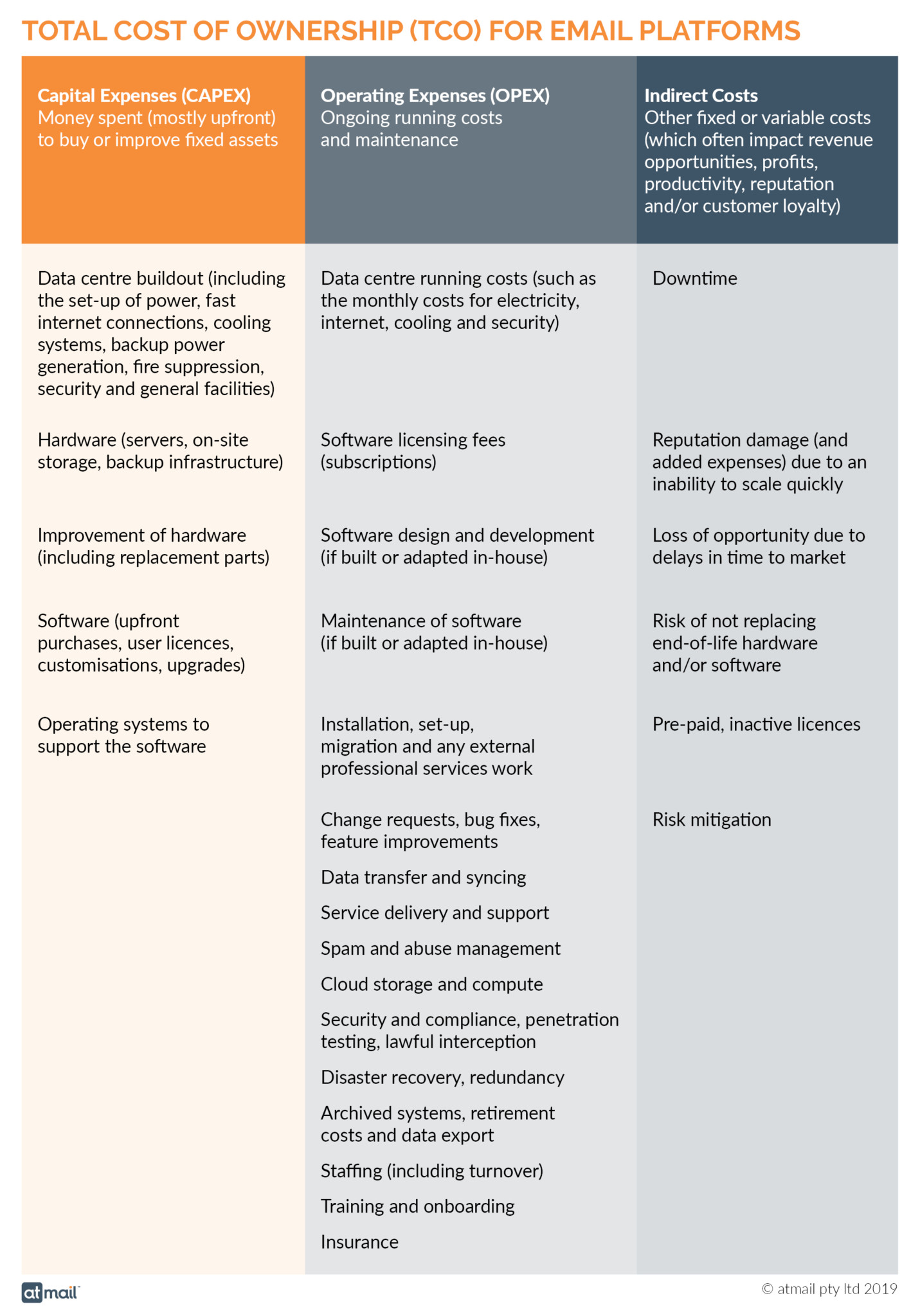
What is Email TCO? (and a TCO Checklist)
If you’re a CIO or IT manager with budget responsibilities, you’ll know about TCO. In fact, you’ll probably not just know about it, but you’ll likely dread each time you’re asked to re-evaluate the TCO for assets within your organisation.
For anyone not in the know, TCO stands for ‘total cost of ownership’ and it is exactly what it sounds like: the grand total of how much you pay over an item’s lifetime. It’s an important budgetary factor because upfront, visible, purchase costs alone are not the only costs in an asset’s life.
To calculate the TCO of any IT asset, you also need to consider a laundry list of costs such as:
- Software
- Hardware
- Purchase research
- Implementation
- Data migration
- User licences
- Training
- Integrations
- Customisation
- Maintenance and support
- Security enhancements and bug fixes
- Feature requests
- Disaster recovery and high availability
- Scaling
- Data centre
- Storage
- Downtime
- Depreciation
- Upgrades
- Retirement and data export
- Archived systems
- Inactive licences
Some costs, such as the upfront purchase price, are straight forward and easy to calculate. But it’s the invisible costs that will be harder to quantify in a TCO estimation.
For example:
- Initial deployment training costs can also be deceptive. Sometimes your team(s) might require more than one round of training, which needs to be factored into your costings.
- How often do you need to upgrade your software? What costs are involved with upgrades?
- Of what if you don’t upgrade? What are the potential costs and risks involved with running end of life software?
- If you later decide to go to another system, do you need to pay to decommission your current one? And if so, at what cost?
- And what about the cost of lost opportunity and/or lost productivity if the asset/software/network does not perform as expected:
This difficulty in estimating the TCO of any given product or service can send shivers down a CIO’s spine because “…financial and productivity losses are just the tip of the iceberg. Underperforming networks can also leave many businesses without the ability to accurately capture and analyse data, as well as effectively engage and collaborate with customers and employees in a timely and meaningful manner,” says Anandh Maistry, a former senior manager at both Citrix and Optus’ sister company Trustwave.

What Influences Email TCO?
Total cost of ownership of an email platform can be similarly ambiguous, if you don’t know what to include in your calculations.
So, for anyone comparing email service providers, let’s walk through some of the primary factors to consider and questions to ask…
Hardware and Software
Will you host your own email server(s) on-premises or move your email platform to a cloud services provider?
Self-hosting on-premises can be very expensive, even if it’s amortised over the course of several years, because it’s an upfront CAPEX (Capital Expenditure). But after you own your servers, your costs may go back down… until you purchase new servers again, at which point your upfront outlay will balloon once more.
Cloud-based services, on the other hand, are an OPEX (Operating Expenditure). They allow you to get up and running very quickly, without significant upfront purchase costs. A dual benefit of cloud providers is that because those companies own their servers, it’s their responsibility to keep up with equipment maintenance, which makes one less ongoing cost you need to worry about.
Then from a front end perspective, you’ll need to consider the email software component. Are you going to buy/subscribe to an off-the-shelf email platform, or ambitiously try to build your own?
Staffing
Who’s going to run and maintain the hardware and/or software that powers your email solution? Larger companies might have full-time employees that maintain, run, and troubleshoot their email system. No matter how many IT people you have on staff, if you’re running an email system, you’re going to pay for it. That’s another expense that figures into TCO.
If you decide not to bring on email specialist staff to help out with your system, can you pay extra in a cloud subscription for added tech support? Will it save you money in the long run?
Upgrading and Expanding
Preserving data integrity, maintaining security and ensuring smooth transition mean you also need to be serious about your upgrades, expansions and migrations.
With both on-premises and cloud solutions, upgrading and expansion costs also need to be considered. After a while, your self-hosted servers will need to be replaced. They may slow down to the point where they’re problematic, or you may just need more space or power. Investing earlier on will put this expense off, but no server lasts forever. And upgrading your servers can be a complicated process.
On the flip side, if you decide to go with a cloud-based email solution, you may find that your base plan is not able to scale and you might need to move up to a more expensive subscription plan or migrate to a new email service provider with better scalability. Either way, it needs to be in your TCO calculations.
Downtime
While you’d probably rather not think about it, there is an additional invisible cost that you may have to deal with: downtime. You won’t actually take money out of your bank account to cover it, but the loss in productivity is a real cost when email platforms go down and/or consume in-house staff time to urgently repair.
Because so many companies rely on email for nearly every facet of their productivity, server downtime is a serious issue. If you aren’t getting 99.9% or 99.99% server uptime, you could be facing a serious amount of lost productivity. For example, Let’s take a company of 100 people who make an average of $60/hour. Even if only half of their work involves email, when their email is down, they could lose $3,000 of productivity per hour. That’s a lot.
Checklist for estimating email TCO
To help you compare email solutions and email service providers, here are some questions you might like to consider to help you calculate your total cost of email ownership:
- Are you looking to build or buy your email platform?
- If building:
- Do you have an in-house team of email experts?
- If not, what is the opportunity cost of taking technical resources away from your core business?
- As Daniel Viney, atmail’s Director of Innovation, says, “atmail has been building and supporting email platforms for 20 years and we can tell you that it is a full-time gig and it is not for the faint-hearted.”
- With end users demanding instantaneity, is your in-house team able to sustain a 99.99+% uptime, provide ongoing maintenance, bug fixes, security enhancements, comply with GDPR and other legislative requirements, deliver new feature requests and provide a desirable user experience that syncs instantly with all mobile devices?
- If so, at what visible (and invisible) cost?
- Do you need a premium spam offering?
- Do you need an on-premises or a cloud solution?
- If your organisation, industry or country requires any form of data sovereignty, are you restricted to on-premises only?
- If you’re moving to the cloud to try to decrease your in-house resources and equipment, do you need private or shared? In-country or offshore?
- Do you need to pay for other software and/or storage costs to build your email platform?
- Can (and at what cost can) your own email platform scale as your business grows?
- Do you have an in-house team of email experts?
- If buying:
- Do you need front end (webmail) and/or back end (mail server)?
- Do you need partial or full technical support?
- If you have an in-house team for support, what is the opportunity cost of taking technical resources away from your core business?
- Do you require external professional services for additional customisations or integrations?
- What is the pricing model (including both upfront and ongoing costs)?
- When is the product due for end of life (EOL) and/or what costs are involved in upgrades?
- Do you need a premium spam offering?
- Can (and at what cost can) the email platform scale as your business grows?
- Do you need an on-premises or a cloud solution?
- Remember: If your organisation, industry or country requires any form of data sovereignty, you may be required to maintain all of your data on-premises and/or in-country.
- If building:
“Think of commercial software as a house and open source software as everything you need to build a house — raw lumber, nails, sheet rock, windows, plumbing fixtures and the rest. You can spend your money and buy the house, or you can spend your time and build the house. Either way, you pay for your house.” Raj Sabhlok
Understand (and Minimise) Email TCO
In summary, the total cost of ownership of an email solution can vary widely based on the choices you make. Understanding how these choices interact and what they mean for your bottom line is a matter of research and working closely with a trusted email provider to make sure that the tools you get are the best for your particular situation.
Just because a solution looks affordable on paper doesn’t mean you’re seeing the whole picture. But at least if you know what questions to ask and you spend time digging into the numbers, hopefully you’ll get a much more detailed picture – and as a result, a much better appreciation about how to both estimate and reduce your TCO.
Good luck!
Want to download our free white paper: Reduce Email Costs? Click here
Update 9 May 2019:
We recently put together this new table for the Total Cost of Ownership (TCO) for email platforms.
We encourage telcos and service providers to use it as a starting point for calculating the TCO of your own customer email platform.

New to atmail?
With 20 years of global, white label, email expertise serving telecommunications and hosting providers across every continent, you can trust us to keep your email platform secure, reliable and private. We offer user-friendly, white labelled, cloud hosted email with 99.99% uptime and your choice of US or (GDPR compliant) EU data centres. If you want to stay in-house, we offer on-premises webmail and/or mail server options. We power 170 million mailboxes worldwide and our customer satisfaction rating is 99%.
So, if you’re looking for a trusted email services provider to manage your customer email for you, so that your technical team can hand over email management and get back to core business, we can help.
Written by Dann Albright and Andrea Martins

